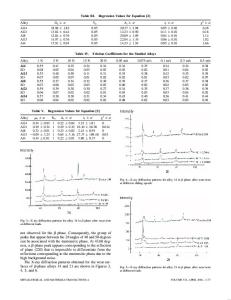Wear behavior of As-cast ZnAl27/SiC particulate metal-matrix composites under lubricated sliding condition
- PDF / 1,150,293 Bytes
- 5 Pages / 612 x 792 pts (letter) Page_size
- 42 Downloads / 362 Views
Thermodynamic Modeling Results (Stable Equilibria) of Isothermal or Adiabatic Reactions of (1 Mol Ti 1 1 Mol Al), in Vacuum and under Nitrogen
Tstart (7C)/Atmosphere 700 800 700 800
/ / / /
vacuum vacuum 10.08 mol N2 10.08 mol N2
Drxn H at Tstart (kJ)
Equilibrium Phases at Tstart (Mol Atoms)
Tfinal (Adiabatic) (7C)
289 288 2144 2143
2.0 g 2.0 g 1.41 g 1 0.75t2 1.41 g 1 0.75t2
1490 1500 1872 1949
the Ti-base metal. Upon subsequent aluminization at 800 7C for 5 hours, the outer layer was converted to TiN 1 AlN 1 TiAl3, with the TiAl3 extending to a depth of some 20 mm. The results of Kabbaj et al.[5,6] can be very clearly understood based on the present ternary phase equilibrium and stability diagrams. When nitriding the ‘‘Ti-Al-N’’ samples, we start with a saturated (Ti-rich) TiAl3 layer and—upon increasing PN2—enter first the narrow TiAl3 1 d phase field in Figure 2(b). This results in the observed d(TiN12x) precipitation; the released aluminum can easily diffuse toward the Ti base in view of the very high diffusivity of Al in TiAl3.[7] Eventually, the conditions of the AlN 1 d 1 TiAl3 three-phase field in Figure 2(b) may be locally obtained in the outer layer, producing the observed AlN traces at higher temperature. It should be noted that we have quantitatively calculated the respective diagrams at all relevant temperatures (not shown here) but refer in this discussion to the qualitatively similar 1000 7C section. In the second set of samples (‘‘Ti-N-Al’’), we start with a d(TiN12x) layer and—upon addition of Al—clearly enter the three-phase field AlN 1 d 1 TiAl3 in Figure 2(a). Any nitrogen ‘‘released’’ by this reaction will be directly converted to AlN. Eventually, aluminum will shortcut diffuse through the TiAl3 in this three-phase mixture to form more TiAl3 directly with the Ti-base metal. This results exactly in the observed microstructure. These coatings are not thermodynamically stable because of the nonequilibrium TiAl3/Ti interface. In fact, TiAl3 completely disappeared after annealing at 900 7C for 30 hours due to the reaction with Ti, and beyond this point, the oxidation resistance is distinctly reduced.[6] Already after 8 hours at 900 7C, the TiN and AlN phases were consumed, in association with the formation of ‘‘Ti2AlN’’ (t2).[6] The underlying reactions can be clearly interpreted using Figure 2. The reaction of TiAl3 with Ti results in the formation of the subaluminides TiAl2, g, and a2, and all three of them are in equilibrium with the ternary nitride t2 (metastable equilibrium for a2). Following this cascade from TiAl3(1AlN 1 d) toward the broad aTi field, the first phase to vanish is AlN when the TiAl3 1 d equilibrium is locally established at the outer layer. Second, d(TiN12x) will be consumed in the three-phase reaction TiAl3 1 d → t2, leaving TiAl3 1 t2 in the outer layer, just as observed. Eventually, the TiAl3 layer would be entirely consumed. The relatively small amounts of Al and N introduced in the initial coatings can be easily accommodated in solid solution in aTi in a final
Data Loading...











